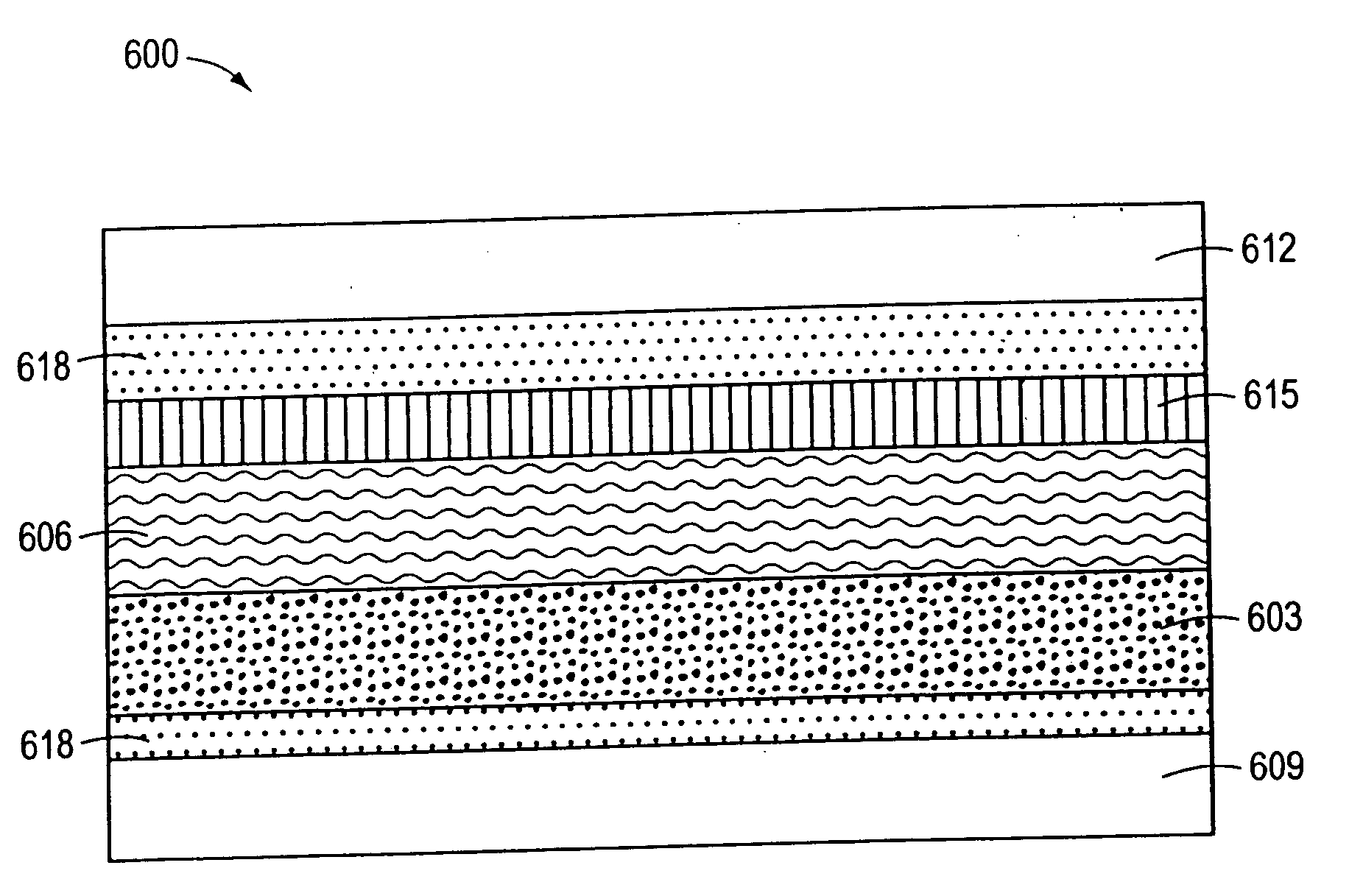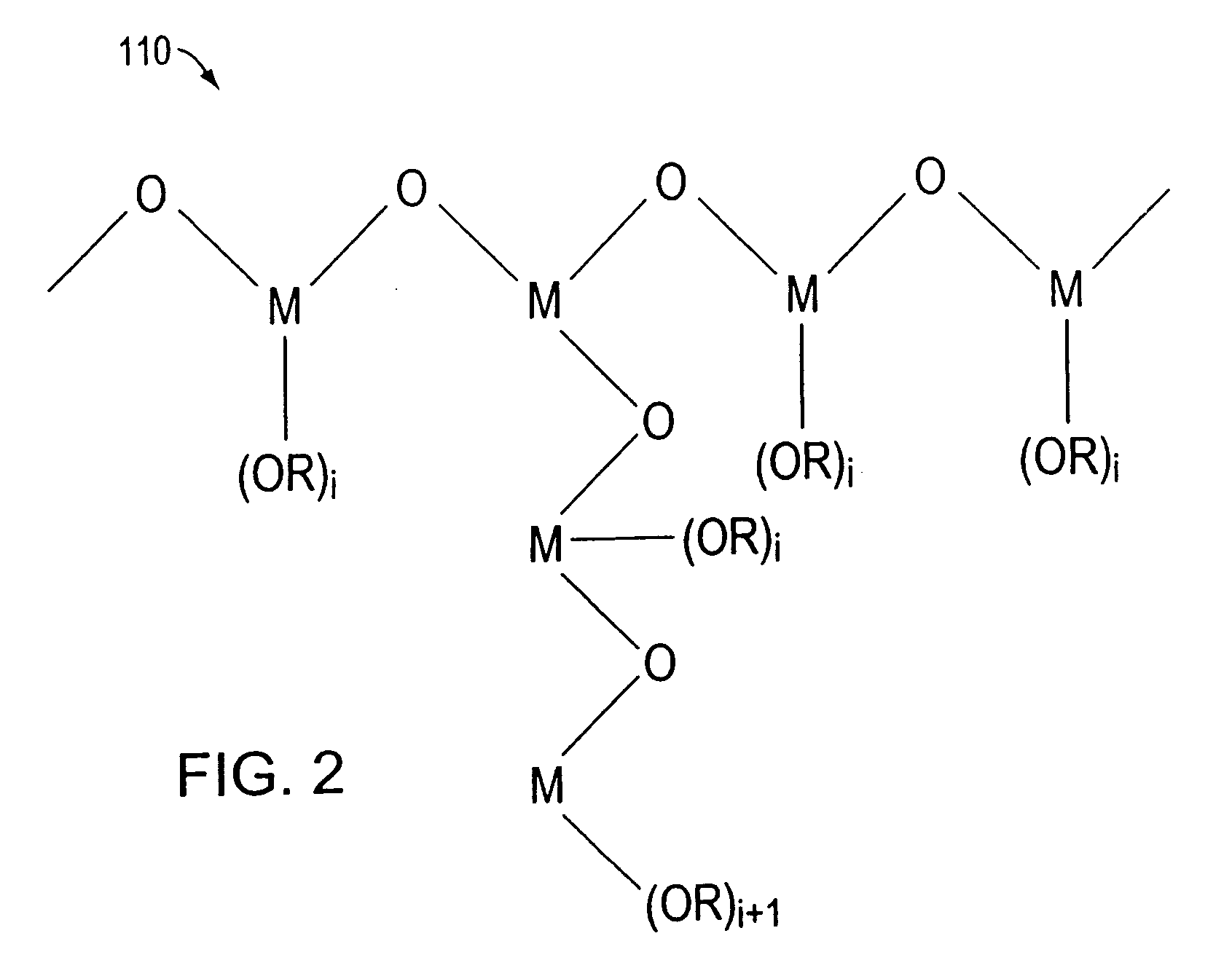Gel electrolytes for dye sensitized solar cells
a solar cell and electrolyte technology, applied in the field of electrolyte compositions for dye sensitized photovoltaic cells, can solve the problems of limited batch manufacturing, long-term stability problems, and inability to meet the needs of electrolyte, and achieve the effect of improving performan
- Summary
- Abstract
- Description
- Claims
- Application Information
AI Technical Summary
Benefits of technology
Problems solved by technology
Method used
Image
Examples
example 1
Dip-Coating Application of Polylinker
In this illustrative example, a DSSC was formed as follows. A titanium dioxide nanoparticle film was coated on a SnO2:F coated glass slide. The polylinker solution was a 1% (by weight) solution of the poly(n-butyl titanate) in n-butanol. In this embodiment, the concentration of the polylinker in the solvent was preferably less than 5% by weight. To interconnect the particles, the nanoparticle film coated slide was dipped in the polylinker olution for 15 minutes and then heated at 150° C. for 30 minutes. The polylinker treated TiO2 film was then photosensitized with a 3×10−4 N3 dye solution for 1 hour. The polylinker treated TiO2 film coated slide was then fabricated into a 0.6 cm2 photovoltaic cell by sandwiching a triiodide based liquid redox electrolyte between the TiO2 film coated slide a platinum coated SnO2:F glass slide using 2 mil SURLYN 1702 hot melt adhesive available from DuPont. The platinum coating was approximately 60 nm thick. The...
example 2
Polylinker-Nanoparticle Solution Application
In this illustrative example, a 5.0 mL suspension of titanium dioxide (P25, which is a titania that includes approximately 80% anatase and 20% rutile crystalline TiO2 nanoparticles and which is available from Degussa-Huls) in n-butanol was added to 0.25 g of poly(n-butyl titanate) in 1 mL of n-butanol. In this embodiment, the concentration of the polylinker in the polylinker-nanoparticle solution was preferably less than about 50% by weight. The viscosity of the suspension changed from milk-like to toothpaste-like with no apparent particle separation. The paste was spread on a patterned SnO2:F coated glass slide using a Gardner knife with a 60 μm thick tape determining the thickness of wet film thickness. The coatings were dried at room temperature forming the films. The air-dried films were subsequently heat treated at 150° C. for 30 minutes to remove solvent, and sensitized overnight with a 3×10−4 M N3 dye solution in ethanol. The sens...
example 3
DSSC Cells Formed without Polylinker
In this illustrative example, an aqueous titanium dioxide suspension (P25) containing about 37.5% solid content was prepared using a microfluidizer and was spin coated on a fluorinated SnO2 conducting electrode (15 Ω / cm2) that was itself coated onto a coated glass slide. The titanium dioxide coated slides were air dried for about 15 minutes and heat treated at 150° C. for 15 minutes. The slides were removed from the oven, cooled to about 80° C., and dipped into 3×10−4 M N3 dye solution in ethanol for about 1 hour. The sensitized titanium dioxide photoelectrodes were removed from dye solution rinsed with ethanol and dried over a slide warmer at 40° C. The sensitized photoelectrodes were cut into small pieces (0.7 cm×0.5-1 cm active area) and sandwiched between platinum coated SnO2:F-transparent conducting glass slides. A liquid electrolyte containing 1 M LiI, 0.05 M iodine, and 1 M t-butyl pyridine in 3-methoxybutyronitrile was applied between th...
PUM
| Property | Measurement | Unit |
|---|---|---|
| temperature | aaaaa | aaaaa |
| temperature | aaaaa | aaaaa |
| temperatures | aaaaa | aaaaa |
Abstract
Description
Claims
Application Information
 Login to View More
Login to View More - R&D
- Intellectual Property
- Life Sciences
- Materials
- Tech Scout
- Unparalleled Data Quality
- Higher Quality Content
- 60% Fewer Hallucinations
Browse by: Latest US Patents, China's latest patents, Technical Efficacy Thesaurus, Application Domain, Technology Topic, Popular Technical Reports.
© 2025 PatSnap. All rights reserved.Legal|Privacy policy|Modern Slavery Act Transparency Statement|Sitemap|About US| Contact US: help@patsnap.com



